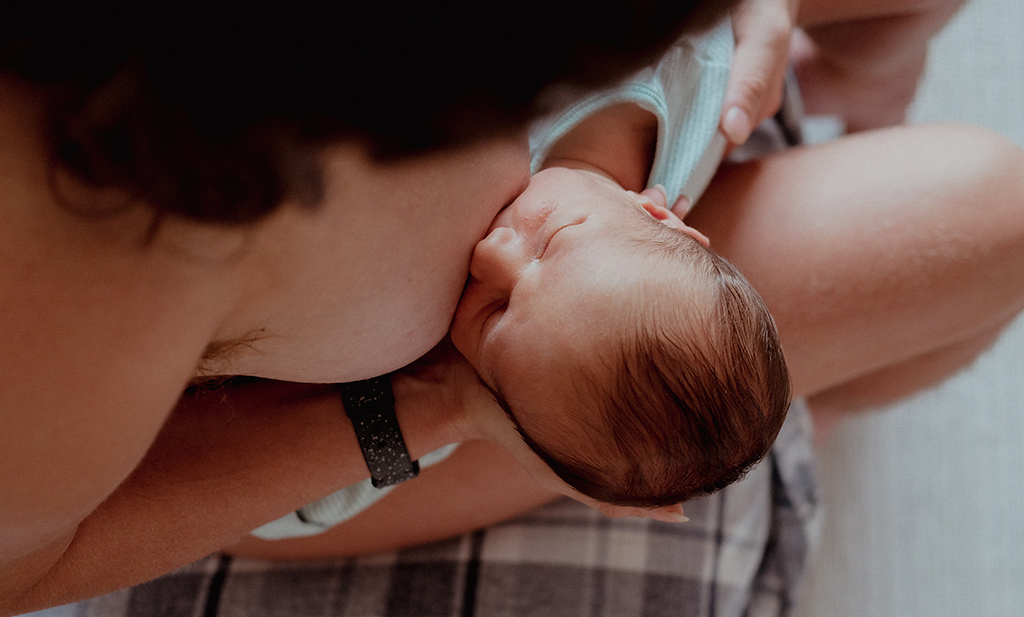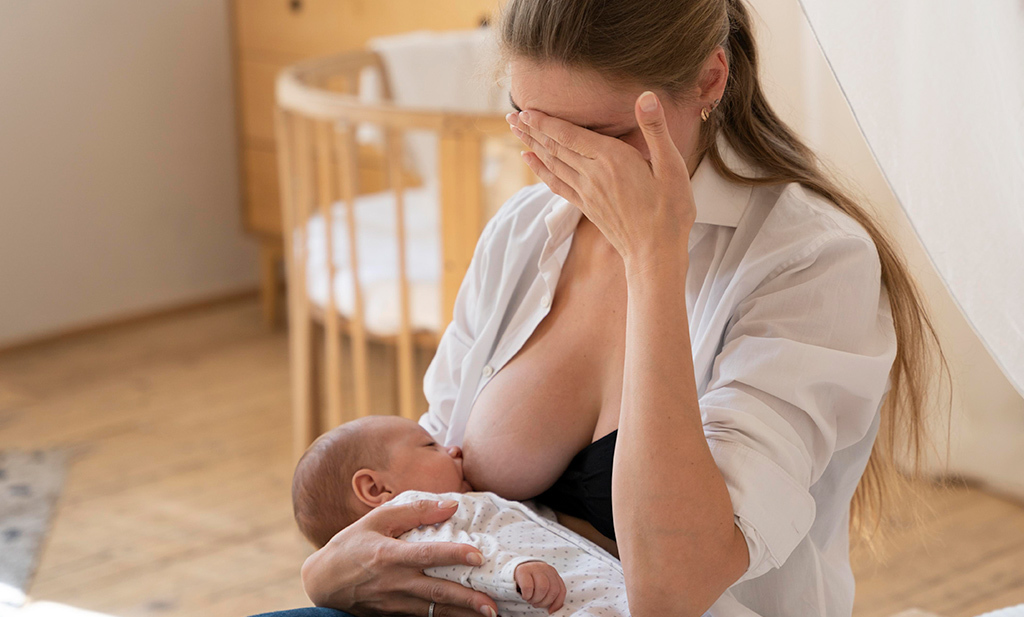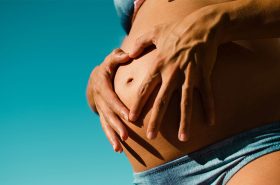
The first few days after birth can be quite exhausting and tiring for most breast/chest feeding mothers.
People often talk about a “breast/chest feeding marathon”, as your baby is expected to drink every two to three hours. This is normal and may take a few days for your milk production to adjust to your baby’s needs. In the first three days, your baby may need between 2 to 20 ml of colostrum per meal, and then switch to transition milk from day four. Then, from day fifteen, you will be breast/chest feeding mature breast/chest milk.
However, breast/chest feeding does not always go smoothly. In most cases, pain during breast/chest feeding is caused by sore or cracked nipples. Our midwife Katrin Ritter explains how you can prevent sore nipples and milk engorgement and what can help you if it does happen.
How to avoid painful nipples.
According to a US study, breast/chest feeding problems in the first three to seven days after birth are the biggest reason why mothers stop breast/chest feeding. Many chest/breastfeeding problems in the early postpartum period can be avoided if you keep a few important things in mind. The first hour after birth is the most important foundation stone for a successful chest/breastfeeding journey. You can read more our blog article here. The second element is breast/chest feeding itself and especially the correct docking position, because this can prevent painful nipples. Read more here.
Our midwife Katrin Ritter shares a few tips:
1. The optimal position: Mum and baby should be comfortable while breast/chest feeding. It’s best to try different sitting and lying positions and vary them from time to time. Our ergonomic Natural CurveTM feeding pillow allows a relaxed position and helps you to keep your baby in the right position. Proven positions are the cradle position, the cross position, and the back position.
For the first few days and in the weeks after, a reclined breast/chest feeding position is also recommended. Your baby lies on their stomach on the reclined mother and can dock with help of their early childhood reflexes. It is important that there is no pressure on the shoulders, upper back, and head. The mother is well supported in the lower back and make sure that your baby does not slide down. A bonding top can help.

2. Your baby comes to your breast/chest – not the other way round: Once you have found a good position, your baby latches on or you quickly pull them to the breast/chest when their mouth is wide open (>=120°). Your little one should take a large part of the lower areola into their mouth while breast/chest feeding, and your nipple should touch their palate.
3. The correct body position: Your baby’s ear, shoulder and hip are always in line, i.e., your baby’s head is NOT turned. Your baby’s feet are in contact with a pillow or with you, so that it can regulate and relax better (this can also be your arm).
Your baby lies with their mouth at the level of the nipple.
4. The correct mouth position: Their mouth is wide open (>= 120 °). The upper lip is slightly turned out and loose (red lip is visible). The lower lip is turned outwards (tongue lies over the lower teeth line). Your baby should have chubby cheeks when drinking (no straw cheeks).
Their head is slightly over-extended. Nose and/or chin touch the chest. A rolling movement of the lower jaw is visible (the ears wiggle). The tongue moves rhythmically.
Final check: Mum should feel no pain and your nipples feel good.
At the end of the meal, your baby is satisfied and relaxed.
5. Nipple care: Your nipples will be slightly strained when you start breast/chest feeding. A slight sensitivity is therefore normal in the first few days. You can make life easier for yourself by not wearing a tight nursing bra or nursing pads for the first few days. In addition, use nipple cream made from ultra-pure lanolin – a natural product obtained from sheep’s wool. This moisturises and supports healing. It’s harmless for your baby, so there’s no need to wash off lanolin before breast/chest feeding.
Alternatively, dab your nipples with a few drops of breast/chest milk and let them air dry. Do not do this if you have fungal infections (thrush).
A nipple shield between breast/chest feeds also prevents friction with your clothing and can ease discomfort. Hydrogel pads also cool and relieve pain.
6. Avoid infections: Always wash your nipples carefully with water after breast/chest feeding. Since germs multiply more quickly in a moist environment, it also helps to let your nipples air-dry more often. Disposable or washable wool-silk nursing pads can absorb leaking breast/chest milk, but should be changed regularly, otherwise they become breeding grounds for germs.

What to do if your nipples become sore
If your nipples become sore, it is important to act. If you don’t do anything about it, the problem can quickly get worse, and your nipples may even crack or bleed.
Here are a few tips to help reduce the pain:
- Breast/chest feed your baby on the less affected side first.
- Find a comfortable breast/chest feeding position.
- Latch on before your baby becomes very hungry. The greater the hunger, the stronger the sucking behaviour.
- If possible, position the sore part of the nipple in the corner of your baby’s mouth to reduce pressure and pain.
- Focus on the technique: is your baby’s mouth level with your nipple? Is your baby’s nose and chin touching your breast/chest? Is baby lying tummy to tummy? Are their ear, shoulder, and hip in line? Does baby have your nipple AND part of the areola in their mouth? Does your little one has their mouth “full of breast/chest”?
- To release the vacuum, push your little finger into the corner of your child’s mouth to dock.
- Use a nipple shield/donut to prevent sore nipples from rubbing against the fabric.
- Use hydrogel liners or cold compresses to cool and care for the sore nipple.
- Be patient. Sore nipples usually settle down after a few days, when your breasts/chest have become accustomed to breast/chest feeding and your baby is sucking better.
If you experience pain, contact your midwife or lactation consultant early on. If you have an infection, you may need to be prescribed medication.
Painful nipples and their unpleasant consequences.
Sometimes breast/chest pain is not caused by your nipples, but by milk retention or breast/chest inflammation. As soon as your milk comes in, your breasts/chest will become fuller and firmer. If your baby is drinking frequently, there should not be a problem.
However, if your baby falls asleep while breast/chest feeding and therefore does not drink enough milk, it can become painful and cause milk engorgement. This can also happen if a milk duct is blocked. You will notice this because your breast/chest will be warmer and sensitive to pressure in the area. It is important to remove the blockage to minimise the risk of mastitis, an inflammation of the breast/chest. Mastitis can also develop if germs enter the milk ducts through the injured nipples. You can find out more about how to recognise a milk stasis and mastitis and what you can do here.
To avoid painful nipples or milk engorgement, it is important to learn about breast/ chest feeding during pregnancy and to consult a midwife or lactation consultant promptly if you have any questions or problems.



